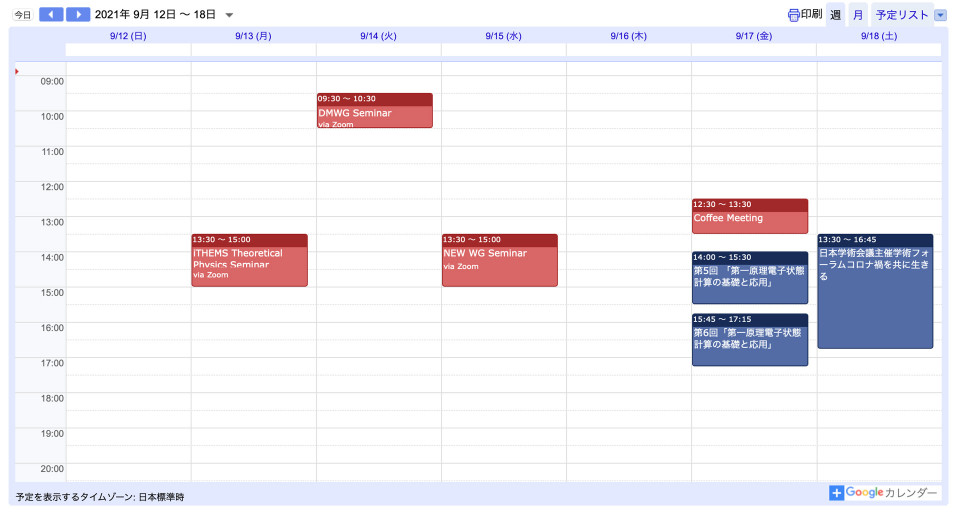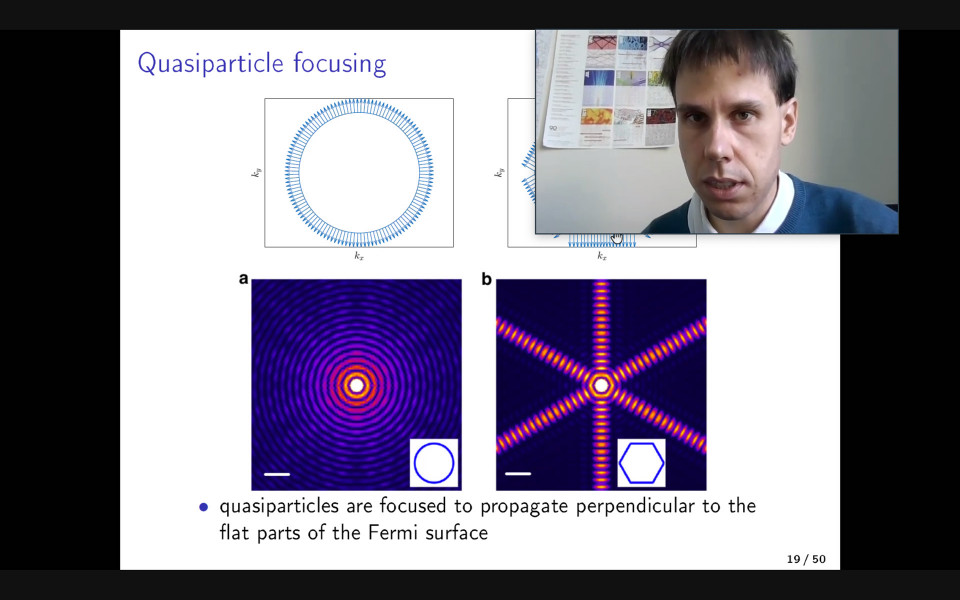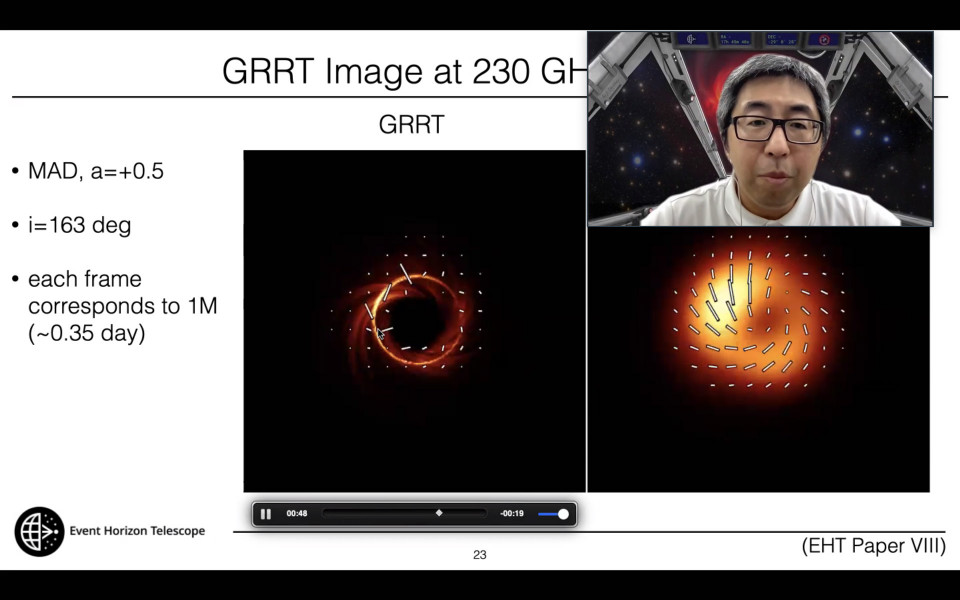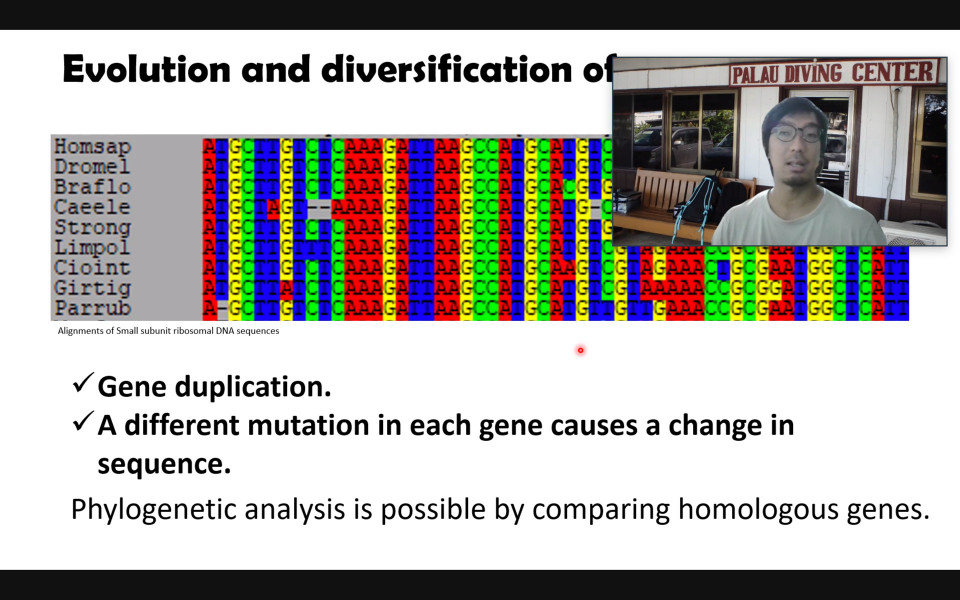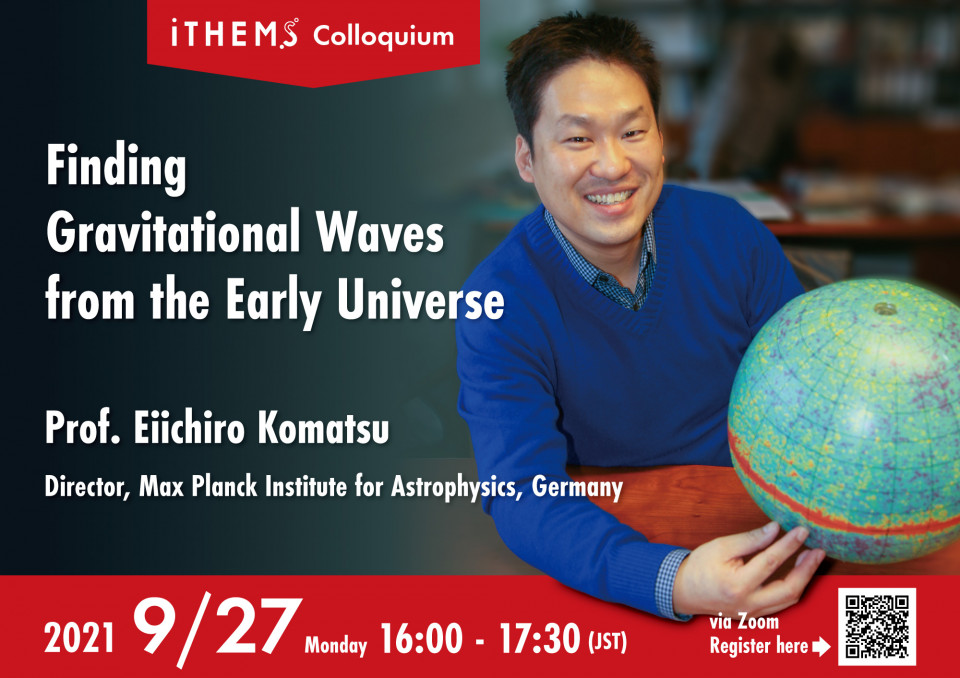Volume 165
Back to Newsletter List
Event Schedule
Events for the 3rd week of September 2021
2021-09-09
Monday, September 13, 13:30- iTHEMS Theoretical Physics Seminar
Tuesday, September 14, 9:30- DMWG Seminar
Wednesday, September 15, 13:30- NEW WG Seminar
Friday, September 17, 12:30- Coffee Meeting
Seminar Report
Quantum Matter SG seminar by Dr. Levente Rózsa on September 1, 2021
2021-09-03
Dr. Levente Rózsa gave a talk about Yu-Shiba-Rusinov (YSR) states and other localized states appearing in superconductors for Quantum Matter Study Group on September 1st, 2021. There are three distinct types of localized in-gap states in superconductors —- Majorana bound states, YSR states, and Caroli-de Genne-Matricon states. Dr. Rózsa first introduced Majorana bound states emerging in topological superconductors. Next, he talked about the anisotropic spacial distribution of the YSR states on the La surface (0001). The YSR state is a localized in-gap state induced by magnetic impurity in a superconductor. He showed that this anisotropy stems from the anisotropic Fermi surface. Furthermore, he discussed the localized states appearing in vortex cores are Caroli-de Genne-Matricon states, instead of Majorana bound states. He went through the experimental details and compared them with his theoretical simulation. The talk was well-organized and clear. We thank Dr. Rózsa for sharing his interesting research works.
Reported by Thore Posske (University of Hamburg, Germany) and Ching-Kai Chiu
Extended and interacting bound states in elemental superconductors
September 1 (Wed) 16:00 - 17:15, 2021
Seminar Report
ABBL-iTHEMS Joint Seminar by Dr. Yosuke Mizuno on September 3, 2021
2021-09-09
Prof. Yosuke Mizuno (Tsung-Dao Lee Institute, Shanghai JiaoTong University) gave an excellent talk on "The Polarised ring ofthe Supermassive Black Hole in M87: EHT observations andtheoretical modeling". He introduced that the Event HorizonTelescope (EHT) had mapped the central compact radio source of theelliptical galaxy M87 at 1.3 mm with unprecedented angular resolution. Recently EHT provided new images of the polarised emissionaround the central black hole in M87 on event-horizon scale. Thispolarised synchrotron emission probes the structure of magnetic fieldsand the plasma properties near the black hole. He and hiscollaborators found that the net azimuthal linear polarisationpattern may result from organised, poloidal magnetic fields in the emission region. In a quantitative comparison with a large simulated polarimetric image library, he found that magnetically arrested accretion disks are favoured to explain polarimetric EHT observations. In this talk, he also discussed about a new modelling study of M87jets in the collimation and acceleration region.
Reported by Shigehiro Nagataki
The Polarised ring of the Supermassive Black Hole in M87: EHT observations and theoretical modeling
September 3 (Fri) 14:00 - 16:00, 2021
Seminar Report
iTHEMS Biology Seminar by Dr. Euki Yazaki on September 9, 2021
2021-09-09
Molecular phylogenetic analysis is one of the most important analysis methods in biology. If used well, it can help us understand how organisms diversified and how genes evolved. The methods of molecular phylogenetic analysis are subject to debate, so we are familiar with the mathematical background. However, we are not so familiar with how the data sets for phylogenetic analysis are made up. In this Biology Seminar, the main alignment algorithms for making data sets were explained and discussed. Scoring is important in alignment algorithms, and there was a discussion on scoring for amino acid and nucleic acid mutations and scoring for gap penalties. The discussion on alignment distance was also heated. I hope the audience all enjoyed it. I would like to have another discussion on phylogenetic analysis and mathematical background next time. Thank you very much!
How to make a dataset for phylogeny and the background of mathematical theory
September 9 (Thu) 10:00 - 11:00, 2021
Upcoming Events
Seminar
NEW WG Seminar
Towards a description of amorphous solids and viscoelastic materials using effective field theory and holographic methods
September 10 (Fri) 13:30 - 15:00, 2021
Matteo Baggioli (Associate Professor, School of Physics and Astronomy, Shanghai Jiao Tong University, China)
Among the most ubiquitous phases of matter, gases and crystalline solids are definitely the simplest to be described. Their physics is indeed almost entirely textbooks material and it can be summarized within the elegant frameworks of kinetic theory and Debye theory. Liquids and specially viscoelastic systems and amorphous materials (e.g. glasses) exhibit a much richer and complex dynamics with provides a large set of fundamental and unresolved physical questions. Given the tremendous microscopic complexity of these systems, which is manifest in a large landscape of scales and anomalous behaviours, the effective field theory (EFT) paradigm of isolating only a few, but fundamental, information could provide a winning approach. This talk is based on the simple, but indeed extremely difficult, question of whether these phases of matter can be distinguished, classified and understood using emergent and/or fundamental symmetry principles as in their ordered crystal counterpart. More precisely, we will combine EFTs, hydrodynamics and holographic methods to tackle the above question. I will present the most recent developments in this direction and I will discuss with you the most important open questions and avenues to explore in the near future.
Venue: via Zoom
Event Official Language: English
Seminar
iTHEMS Theoretical Physics Seminar
S-matrix Unitarity toward UV Completion
September 13 (Mon) 13:30 - 15:00, 2021
Keisuke Izumi (Assistant Professor, Kobayashi-Maskawa Institute for the Origin of Particles and the Universe (KMI), Nagoya University)
Einstein gravity is not renormalizable and does not hold perturbative unitarity at high energy. This is the main reason why the construction of quantum gravity is difficult. A conjecture was proposed by Llewellyn Smith, "renormalizablility and tree-unitarity at high energy give the same conditions for theories". This conjecture would be important because it shows that, if a theory is constructed s.t. unitarity is satisfied, renormalizablility holds automatically, and vice versa.
Unfortunately, a counterexample was pointed out. If a theory involves higher derivatives, there exists a theory which is renormalizable but does not satisfy tree-unitarity. A candidate of quantum gravity, the quadratic gravity (R_{\mu\nu}^2 gravity), is one of the examples. Therefore, Llewellyn Smith's conjecture would not be useful for the discussion of quantum gravity. Then, we introduce a new conjecture, "renormalizablility and S-matrix unitarity (or often called pseudo-unitarity) at high energy give the same conditions for theories".
In this talk, Llewellyn Smith's conjecture and our contribution to it will be explained. Then, our new conjecture will be introduced. Finally, it will be shown that our conjecture works well even in theories with higher derivatives.
Venue: via Zoom
Event Official Language: English
Seminar
NEW WG Seminar
High-harmonic generation in strongly correlated systems
September 15 (Wed) 13:30 - 15:00, 2021
Yuta Murakami (Assistant Professor, School of Science, Tokyo Institute of Technology)
High-harmonic generation (HHG) is an intriguing nonlinear phenomenon induced by a strong electric field. It has been originally observed and studied in atomic and molecular gases, and is used in attosecond laser sources as well as spectroscopies. An observation of HHG in semiconductors expanded the scope of this field to condensed matters [1]. The HHG in condensed matters is attracting interests since it may be used as new laser sources and/or as powerful tools to detect band information such as the Berry curvatures. Recently, further exploration of the HHG in condensed matters are carried out in various other systems than semiconductors.
In this talk, we introduce our recent theoretical efforts on the HHG in strongly correlated systems [2,3,4]. In contract to semiconductors, the charge carriers are not normal fermions, which makes HHG in strongly correlated systems unclear. Using the dynamical-mean field theory and the infinite time-evolving block decimation for the Hubbard model, we reveal the HHG features in the Mott insulators. Firstly, we reveal that the origin of the HHG in the Mott insulator is the recombination of doublons (doubly occupied sites) and holons (no electron site). Then, we show that the HHG feature qualitatively changes depending on the field strength due to the change of mobility of charge carriers, and discuss that the HHG directly reflects the dynamics of many body elemental excitations, which the single particle spectrum may miss. These results indicate that the HHG in Mott systems may be used as a spectroscopic tool for many body excitations. We also discuss the effects of spin dynamics on the HHG, which is a unique feature in strongly correlated systems.
References
- S. Ghimire, A. D. DiChiara, E. Sistrunk, P. Agostini, L. F. DiMauro, and D. A. Reis, Nat. Phys. 7, 138 (2011).
- Y. Murakami, M. Eckstein, and P. Werner, Phys. Rev. Lett. 121, 057405 (2018).
- M. Lysne, Y. Murakami, M. Schüler, and P. Werner, Phys. Rev. B 102, 081121 (2020).
- Y. Murakami, S. Takayoshi, A. Koga, and P. Werner, Phys. Rev. B 103, 035110 (2021).
Venue: via Zoom
Event Official Language: English
Colloquium
iTHEMS Colloquium
Finding Gravitational Waves from the Early Universe
September 27 (Mon) 16:00 - 17:30, 2021
Eiichiro Komatsu (Director, Max Planck Institute for Astrophysics, Germany)
The Cosmic Microwave Background (CMB) gives a photographic image of the Universe when it was still an “infant”. We have been using it to test our ideas about the origin of the Universe. The CMB research told us a remarkable story: the structure we see in our Universe such as galaxies, stars, planets, and eventually ourselves originated from tiny quantum fluctuations in the period of the early Universe called cosmic inflation. While we have accumulated strong evidence for this picture, the extraordinary claim requires extraordinary evidence. The last prediction of inflation that is yet to be confirmed is the existence of primordial gravitational waves whose wavelength can be as big as billions of light years. To this end we have proposed to JAXA a new satellite mission called LiteBIRD, whose primary scientific goal is to find signatures of gravitational waves in the polarisation of the CMB. In this presentation we describe physics of gravitational waves from inflation, and the LiteBIRD proposal.
Venue: via Zoom
Event Official Language: English
Person of the Week
Self-introduction: Matthias Berwein
2021-09-08
My name is Matthias Berwein and I'm from Germany. I did my undergraduate studies in physics at TU Munich from 2006 to 2011, followed by a PhD 2012-2016 also at TU Munich in the group of Nora Brambilla. Then I came to Japan for my first postdoc at Tohoku University in Sendai under a JSPS fellowship with Yukinari Sumino. Since 2018 I've been at RIKEN, first in the SPDR program at Quantum Hadron Physics Lab, and from 2021 in iTHEMS.
The focus of my research lies in theoretical studies of the strong interactions through the theory of quantum chromodynamics and with a special emphasis on heavy quarks. I have worked on several projects on the static quark potential, heavy quarkonium hybrids, and heavy quarks at finite temperature, using perturbative calculations and effective theory methods. Currently, I'm studying properties of the energy-momentum tensor in these environments. I look forward to many fruitful interactions with fellow researchers here at iTHEMS.
Paper of the Week
Week 2, September 2021
2021-09-09
Title: Subregion Spectrum Form Factor via Pseudo Entropy
Author: Kanato Goto, Masahiro Nozaki, Kotaro Tamaoka
arXiv: http://arxiv.org/abs/2109.00372v1
If you would like to cancel your subscription or change your email address,
please let us know via our contact form.
Copyright © iTHEMS, RIKEN. All rights reserved.


